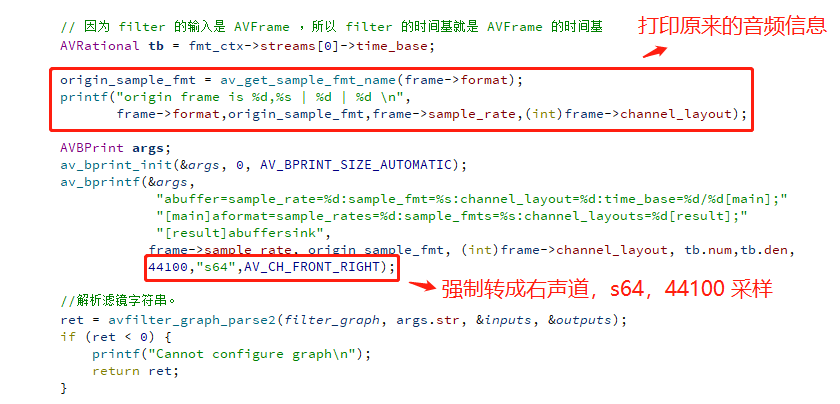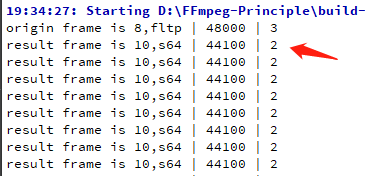FFmpeg 的社群来了,想加入微信社群的朋友请购买《FFmpeg原理》VIP版 电子书,里有更高级的内容与答疑服务。
前面介绍了 FFmpeg 的 format 视频格式滤镜,那很显然,音频也会有一个格式滤镜,用来转换音频采样格式,调整采样率或者声道布局。
音频的格式滤镜叫 aformat,前面加了个 a 而已。
这是 FFmpeg 整个开源项目的命名习惯,不仅仅是格式滤镜,还有 buffer 滤镜 与 abuffer 滤镜,这两个分别是视频,音频的入口滤镜。而出口滤镜是 buffersink 与 abuffersink。
总之,如果你遇到一个视频模块 叫 xxx,通常你在前面加个 a变成 axxx, 就是音频的模块了。
我们可以用以下命令查询 aformat 滤镜支持的参数:
ffmpeg -hide_banner 1 -h filter=aformat

可以看到,aformat 滤镜支持 3 个参数,sample_fmts(采样格式),sample_rates(采样率),channel_layouts(声道布局)。
这 3 个参数也是列表的形式,跟 format 视频格式滤镜一样。
aformat 音频格式滤镜的示例代码在 GitHub 可以下载,重点代码如下:


整个项目的运行结果如下:

可以看到,juren-30s.mp4 的音频帧,原本是 fltp 格式的,经过 aformat 滤镜转换之后,就变成了 s64 格式的了,同时采样率跟声道布局也进行了调整。
FFmpeg 里面定义的音频采样格式,一共有 12 种,枚举 AV_SAMPLE_FMT_NB 的值就是 12。全部都定义在 llibavutil/samplefmt.h 里面,如下:
enum AVSampleFormat {
AV_SAMPLE_FMT_NONE = -1,
AV_SAMPLE_FMT_U8, ///< unsigned 8 bits
AV_SAMPLE_FMT_S16, ///< signed 16 bits
AV_SAMPLE_FMT_S32, ///< signed 32 bits
AV_SAMPLE_FMT_FLT, ///< float
AV_SAMPLE_FMT_DBL, ///< double
AV_SAMPLE_FMT_U8P, ///< unsigned 8 bits, planar
AV_SAMPLE_FMT_S16P, ///< signed 16 bits, planar
AV_SAMPLE_FMT_S32P, ///< signed 32 bits, planar
AV_SAMPLE_FMT_FLTP, ///< float, planar
AV_SAMPLE_FMT_DBLP, ///< double, planar
AV_SAMPLE_FMT_S64, ///< signed 64 bits
AV_SAMPLE_FMT_S64P, ///< signed 64 bits, planar
AV_SAMPLE_FMT_NB ///< Number of sample formats. DO NOT USE if linking dynamically
};
上面这些值是数字,因为滤镜里面使用的是字符串,所以这些枚举数字对应的字符串在 llibavutil/samplefmt.c 里面,如下:
/** this table gives more information about formats */
static const SampleFmtInfo sample_fmt_info[AV_SAMPLE_FMT_NB] = {
[AV_SAMPLE_FMT_U8] = { .name = "u8", .bits = 8, .planar = 0, .altform = AV_SAMPLE_FMT_U8P },
[AV_SAMPLE_FMT_S16] = { .name = "s16", .bits = 16, .planar = 0, .altform = AV_SAMPLE_FMT_S16P },
[AV_SAMPLE_FMT_S32] = { .name = "s32", .bits = 32, .planar = 0, .altform = AV_SAMPLE_FMT_S32P },
[AV_SAMPLE_FMT_S64] = { .name = "s64", .bits = 64, .planar = 0, .altform = AV_SAMPLE_FMT_S64P },
[AV_SAMPLE_FMT_FLT] = { .name = "flt", .bits = 32, .planar = 0, .altform = AV_SAMPLE_FMT_FLTP },
[AV_SAMPLE_FMT_DBL] = { .name = "dbl", .bits = 64, .planar = 0, .altform = AV_SAMPLE_FMT_DBLP },
[AV_SAMPLE_FMT_U8P] = { .name = "u8p", .bits = 8, .planar = 1, .altform = AV_SAMPLE_FMT_U8 },
[AV_SAMPLE_FMT_S16P] = { .name = "s16p", .bits = 16, .planar = 1, .altform = AV_SAMPLE_FMT_S16 },
[AV_SAMPLE_FMT_S32P] = { .name = "s32p", .bits = 32, .planar = 1, .altform = AV_SAMPLE_FMT_S32 },
[AV_SAMPLE_FMT_S64P] = { .name = "s64p", .bits = 64, .planar = 1, .altform = AV_SAMPLE_FMT_S64 },
[AV_SAMPLE_FMT_FLTP] = { .name = "fltp", .bits = 32, .planar = 1, .altform = AV_SAMPLE_FMT_FLT },
[AV_SAMPLE_FMT_DBLP] = { .name = "dblp", .bits = 64, .planar = 1, .altform = AV_SAMPLE_FMT_DBL },
};
你也可以通过 av_get_sample_fmt_name() 函数来获取数字对应的字符串。
转换音频格式也可以使用 swr_convert() 的函数,swr 的全称是 software resample。
不过我个人觉得 swr_convert() 重采样函数使用起来有点复杂。不像滤镜的语法那么统一,只需往入口滤镜丢数据,然后往出口滤镜读数据就行了。
swr_convert() 相关介绍推荐阅读《swr_convert音频重采样介绍》
至此,aformat 音频格式滤镜介绍完毕,
























 1663
1663











 被折叠的 条评论
为什么被折叠?
被折叠的 条评论
为什么被折叠?










